Thursday 19 April 2018
Checking in at Shanghai Hongqiao Airport, we boarded a bus for a nearly 30 min bus ride to the old terminal to board the plane. This was followed by an hour delay while we waited for a take off space. Arriving in Chengdu airspace some 3 hours later we then had to circle to wait for a landing space. Chengdu is a smaller city than Shanghai with a population of around 18 million and is the capital of the the Sichuan Province, home to around 81 million people and a couple of thousand giant pandas.
As we headed off the plane we merged with what seemed like thousands of people who seemed to disappear as we headed into the baggage hall with 25 carousels spread over a few hundred meters. A driver met us and soon we were on a four-lane road heading into town. It was getting late by the time we checked into the very modern JW Marriott hotel, which, like many modern hotels, had its reception on the eight floor.
Friday 20 April 2018
After breakfast I took a stroll down to the Tianfu Square (the main Square). With a large statue of Chairman Mao overlooking it from the north the activity here was somewhat unusual. Soldiers and police seemed to be on full alert. Police wore barbed, riot-type arm guards and carried shields with three in each group. One in the group carried what looked like a spear or an electric cow prodder. Groups of soldiers and police stood in threes in a triangle. Asking around later I couldn’t find a reason for this type of activity; I am quite sure it wasn’t just because we were in town.
Next I headed to People’s Park, which is quite attractive with tea houses, various statues, a stream, ponds and lots of people relaxing. One group of women performed a tai-chi version of line dancing to music. This is apparently very popular in China and often causes confrontations as groups take over parks and squares to practice, to the annoyance of those who like their peace and quiet.
After leaving the park I wandered around a bit until I came across the “city with wide and narrow streets”. This old part of town, with its traditional brick buildings, was recently restored and now is a major tourist attraction. When I say tourist I mean tourists from other parts China. I was the only European guy around and unusual enough that a couple of girls asked to have a photo with me. The streets in this area are clean and well kept as are the shops. An unusual activity here was ear cleaning done outside, the patient in a chair while a guy with a head torch pokes around in his ear with some metal rods. There is a huge variety of food on sale here with stalls and kitchens set up amongst the souvenir shops. At one point I saw a video playing outside a tea house with dancing and other acts on it. After some pointing and paying I was lead in and given a seat near the front. For some time a chap with a bald head and wearing a robe stood up and talked about various bits of calligraphy type art work to which people clapped enthusiastically. After 30 minutes of that a very solemn looking woman sat and played a horizontal harp type device. She was followed by another solemn woman who played a vertical guitar type instrument. Finally a guy with a long-spouted tea pot came out twirling it around and pouring the odd cup of tea from various angles. After nearly two hours I decided I had seen enough and quietly made my way out. I always have a good chuckle at myself when I end up in these situations where I haven’t really got a clue what is going on or how long it’s going to go for. I strolled through a few more streets before heading back to the hotel.
Just outside the hotel there was a big line of these bloody “trip over in the way bikes” to which they were adding more to the line up,and unusually these ones were lined up and in a stand. To be fair I did actually see some people using them around the town.
At around five I was picked up by one of the Royal Canin staff and driven to a really cool restaurant made up of lots of rooms with water features and bridges. There I met Sylvia and the Royal Canin team for a rather interesting meal. Dishes of various things kept arriving at the table, many laced with the local sichuan spices which have an amazing hot taste while making the end of your tongue and lips go numb for a few minutes. Jelly fish, preserved eggs, cow stomach, beans, shrimps, pig trotters, congealed duck blood and tofu ate some of the ones I can remember. To add to the night was a corn wine drunk from small glasses in a skulling type manner as each of the team tool it in turns to stand up and have a ‘cheers’ with me. I am sure China sells this stuff to North Korea to fuel its rockets!!
Saturday 20 April 2018
At 9am Lucia, our guide, and a driver picked us up. We headed out of town on the wide roads, which continued well out into the country. The infrastructure here is very impressive with motorways often running on pilings across the country side. About 50kms to the northwest near Guanghan is the Sanxingdui Museum. This came about some years ago when a local peasant discovered some relics beneath his land and started taking them into the local market to sell them. Then some archaeologists found out and started investigating. Their discoveries have turned Chinese history on its head. The Chinese always believed that China started in China with their history and culture developing from within. Dating back between 3000 and 4800 years these findings show Egyptian and Greek influences. This part of the world was also going through the early bronze age. The museum is set in a nice park with two pavilions separated by colourful gardens and a nice forest. The displays are well done and easy to follow. The lighting allows for good photographs which are the only real way to describe what we saw. There was even one object that looked like a steering wheel.
Interestingly there were also lots of African elephant tusks discovered in burial sights around the area. African elephants never roamed in this area. There was also an area the depicted through maps movies and photos the extent of the excavations over a large area.
Visit over we headed west to Dujiangyn where the Min river emerges from the mountains. This is a pretty big set up with lots of tourists wandering around. We were waved off the street by an enterprising local down a driveway to an empty lot where this guy was running his “make a few bucks in the weekend” parking lot. A short distance away we crossed the Qingshui Jiang river over a ornate footbridge.
On the river bank there is a busy restaurant. David, The GM of Royal Canin China and an expert fisherman, headed to the fish tank and soon had a prize fish in the net, which was cooked and on the table in under ten minutes, along with some other spiced dished. We enjoyed a nice lunch as hawkers wandered past trying to sell various spices, herbs and other produce carried in large baskets.
Back across the river we headed into the Ancient Min River project. This is very impressive. About 2300 years ago the Qin State and Chengdu city was often flooded until Li Bing, a a hydraulic engineer, rocked up and built this amazing water management scheme. First he had the Qingshui Jiang river dug which then branched off into three smaller rivers to irrigate the whole basin. He then diverted the Min river so at normal times the river irrigated the fertile land, boosting the population of the state with many people moving to Chengdu City helping greatly to expand the power of the Qin State.
The river was diverted in such a way that when the floods came the excess water went down the old Min River Channel as it still does today. It has certainly been modified considerably in the last two thousand years with modern dams and spillways but the original design was impressive. A major earthquake in recent years means a lot of the memorial area has been rebuilt, done nicely with water features, statues and nice gardens. Taking a crowded swing bridge then a spillway bridge across a couple of dry channels we headed up river across another crowded swing bridge and up the hill to a pagoda for a good view of the project.
The tour over, we headed to the south side of Chengdu to an old, well-restored part of town to a restaurant that served vegetarian food that looked and was supposed to (but not quite) taste like meat and fish. A tradition from the nearby Tibetan monks area.
Sunday 21 April 2018
Lucia picked us up at 9.30am and we headed northeast to the Chengdu Research Base of Giant Panda.
A bit like a zoo it was well laid out with lots of bush, bamboo, panda merchandise shops and quite a few pandas. Once nearly extinct there are a couple of thousand of of them nowadays, many roaming the nearby hills. The perception is that they are a gentle cuddly bear, ‘wouldn’t heart a fly’ type of animal. Apparently not so, as in the wild they they not only eat bamboo shoots but meat as well. Part of the demise in population was caused by pandas wandering down the paddock and feasting on the odd goat and the peasants retaliating by killing the pandas. It would be quite nice one day to go for a stroll in the hills nearby and see them in the wild. The research centre is sectioned off with the younger pandas and older ones in separate compounds. There is also a breeding area. They seem to spend a lot of time doing not very much and just laying around. Their compounds are surrounded with a ditch with a vertical wall on the outside.
Another area houses the red pandas. They are much more active, often running along the ground and up trees. Their compound is surrounded by a high fence with electric wires on the top.
On the way out we stopped and sent panda postcards to Kirstie and Victoria. It will be interesting to see if they make it to NZ and how long they will take.

We stopped for a nice lunch on the way to the airport and mid afternoon we boarded an A321 for the flight back to Shanghai. We were seated in the back row and just now it’s the changing of seasons in China, which apparently makes for a bit of rough flying. It was quite exciting as the plane bucked its way through the sky at various points during the flight.
A big thank you to David for sticking around over the weekend and showing us the local sites, and his team in Chengdu for organising out guide Lucia.
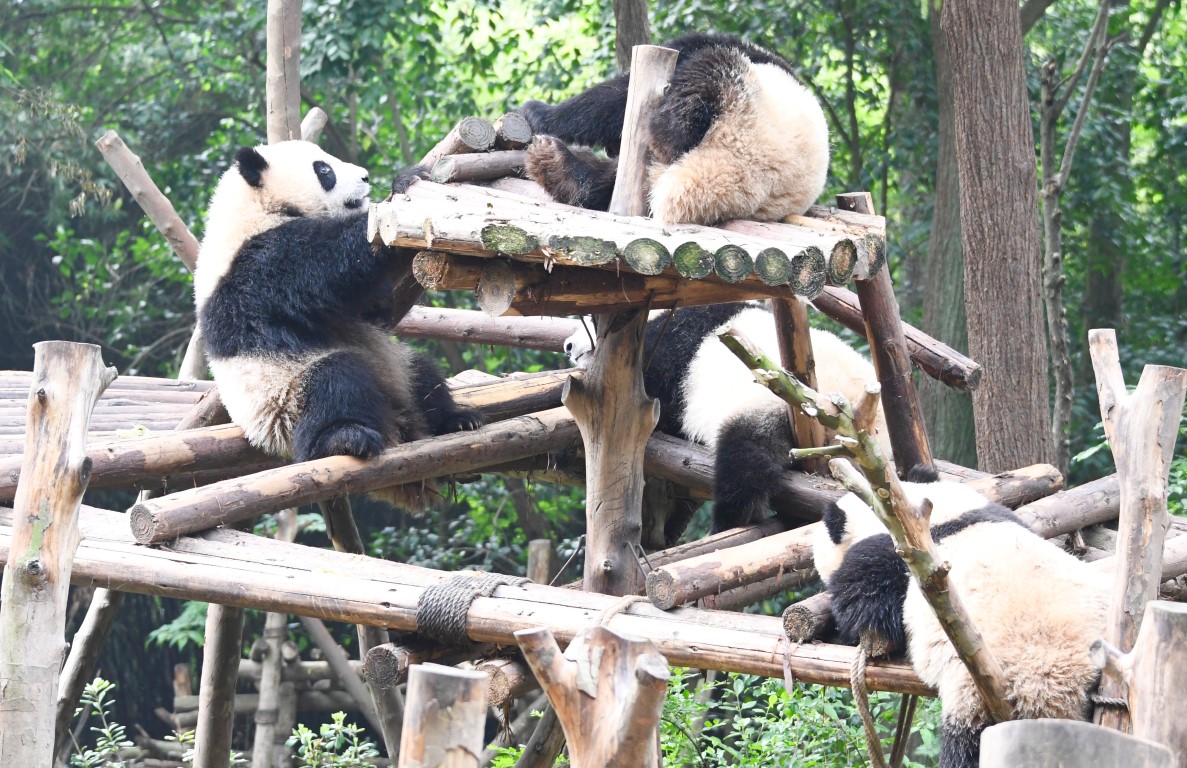











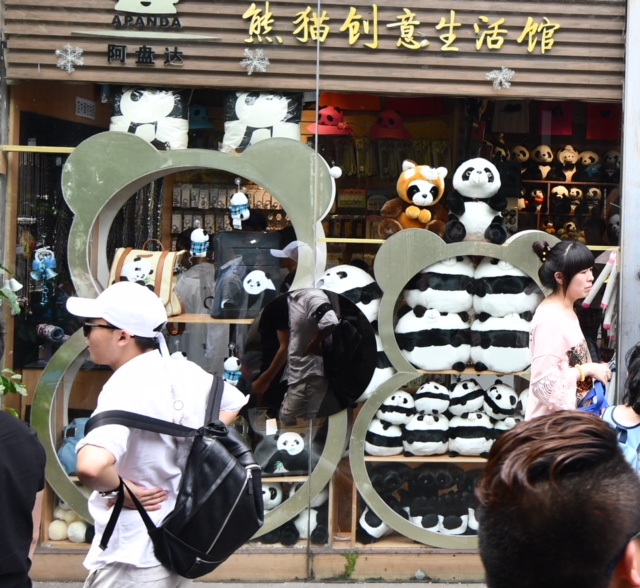



















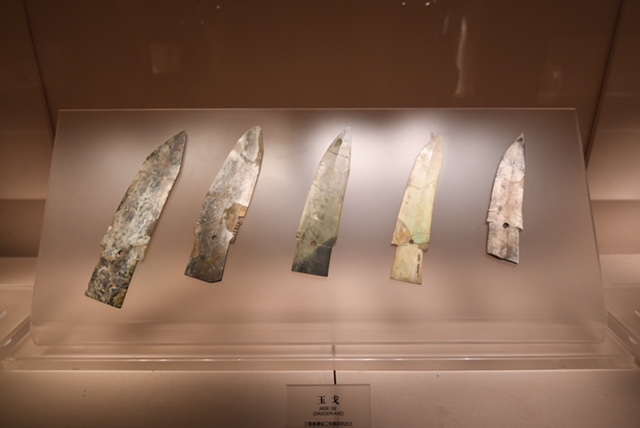




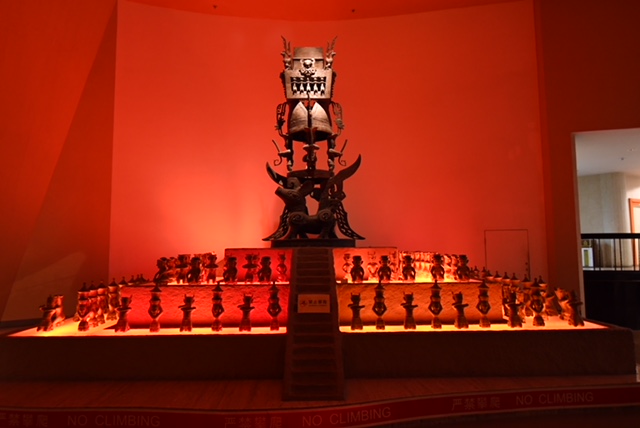






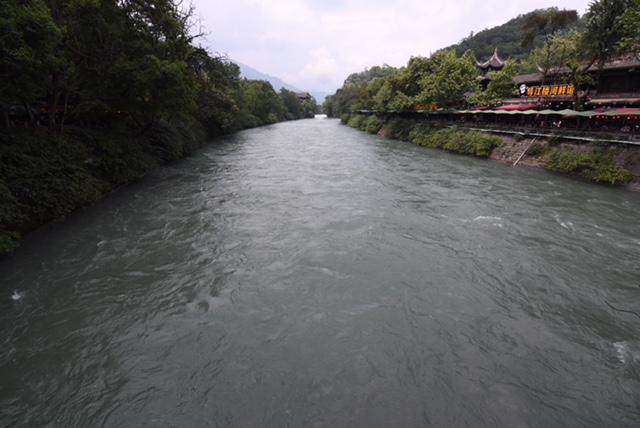

































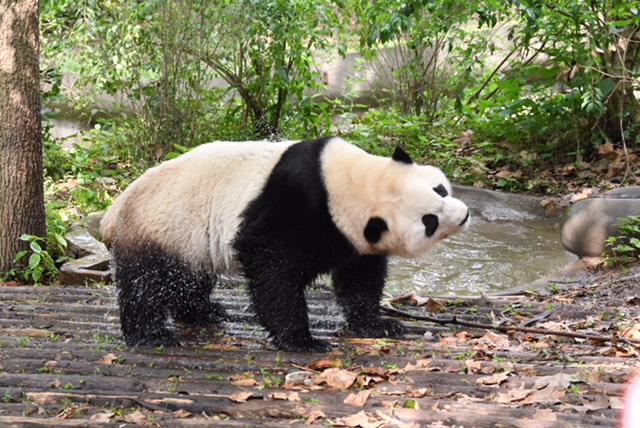









Great comment re Jim Liz. We are in Guangzhou this week. Enjoy the pandas.
Thanks Roger and Sylvia
Off to Chengdu tomorrow for work for a few days – have been before and I am a massive Panda freak so looking forward to more close up Panda watching. Yay yay.
I think Jim was a Panda in a previous life. As you say, mostly the adult male pandas are prone on their back and asleep -very similar to the pose most commonly observed on our couch on a Sunday afternoon. Ha.
Cheers, Liz (Happy panda emoji)
Love those pandas.. esp the one lying on its back eating!
Lovely photo of you both
Thank you again Roger and Sylvie. Very informative. Love the panda photos of course. Looking forward to seeing you soon. Xx